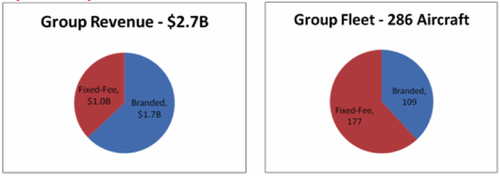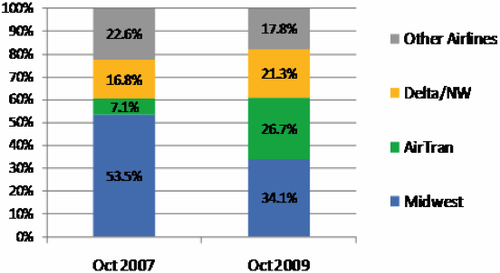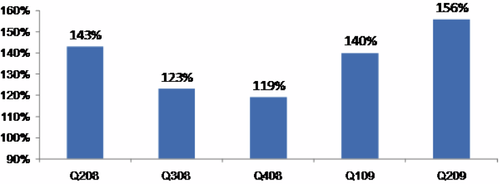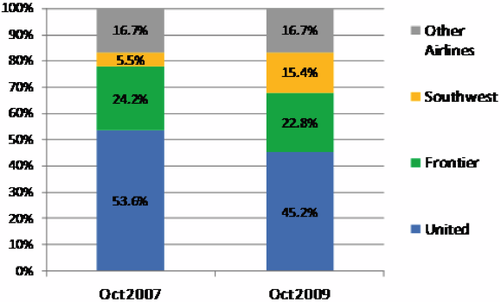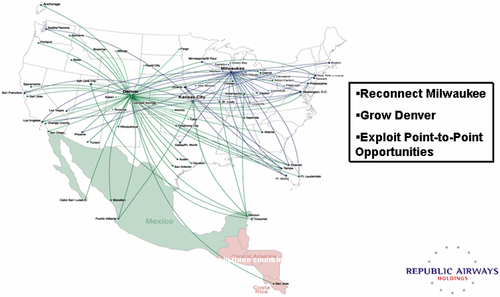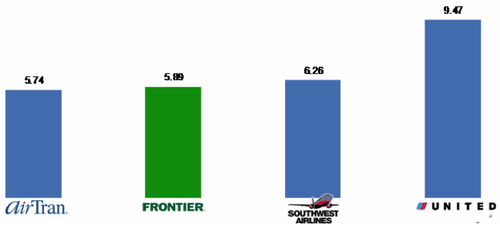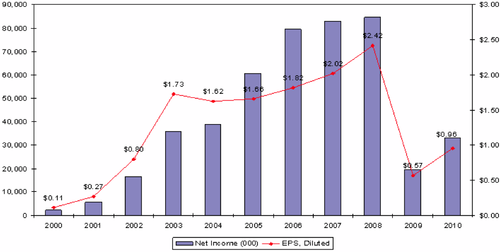Republic Airways provides clearest vision yet of consolidation strategy
Republic Airways Holdings (RJET) CEO Bryan Bedford and CFO Hal Copper provided the clearest vision yet of the evolving company since its acquisition of Frontier and Midwest Airlines, at this week's Next Generation Equity Research (NGER) Airline conference in New York City.
Outlining a new chapter in the US airline industry, Bedford said one of the biggest benefits of the acquisitions was to build solid brands to mitigate any counter-party risk and take advantage of any market opportunities expected from the changes in the US mainline and regional airline industry.
Speaking before analysts, Bedford said he was often peppered with questions as to what he would do should one of the five mainline partners his company flies for "go away." He noted the rumors of bankruptcies amongst the majors were rampant earlier in the year and began his answer by saying he does not think that would happen given efforts this year to increase liquidity and cover debt payments coming due.
"If that does happen," Bedford told investors, "and it creates a real void in the market, we have unique assets that allow us to go in. Our branded service creates an essential hedge on counter-party risk with our partners and it puts us in a better position today than we were, quite frankly, a year ago. Today our fixed fee partners have the ability to honor their obligations and our partners are continuing their capacity restraint, their restructuring and capital raising. We don't think we have risk but this is the airline industry."
Mover and shaker
While questions have arisen about Republic's acquisition moves which were considered risky at the outset, Bedford pointed out the company has been profitable in 33 of its 35-years and is enjoying 31 consecutive profitable quarters, consistent growth, and a diverse set of flying partners. His moves have shaken the industry, according to NGER, who described Bedford as one of the airline industry's most creative strategic thinkers, and as he laid out plans for 2010, analysts were left with nothing to do but agree.
He frankly said that not only would Frontier have survived without Republic's acquisition, but it would have remained a strong competitor in its home-town Denver market. Its consolidation with Midwest Airlines will make it an even stronger competitor giving it access to the all-important business traveler while Midwest gains access to leisure travelers, both critical changes given changes in the low-cost-carrier industry which has been aggressively pursuing the higher yield traffic. Most want to see a 50/50 split between leisure and business and the consolidation of Frontier and Midwest Airlines fits the new business model.
Republic, said Bedford, is anticipating a USD2.7 billion in group revenues for 2010 split between its fixed fee operations with regionals Shuttle America, Republic Airlines and Chautauqua at USD1 billion and the Frontier/Midwest combination at USD1.7 billion. Its major challenges next year would be continued consolidation of back office functions as well as repairing the negative good will resulting from buying the two franchises at such low prices. "That will impact our GAAP earnings next year and we'll have to amortize these intangibles," he said.
Republic Group revenues and fleet: 2010
The biggest question he received early on was whether Republic was trying to be the next ExpressJet or Independence Air which failed when it launched its own branded service in new, point-to-point markets. ExpressJet would have likely followed were it not for its substantial Continental Express operations. However, its bid straddled the fuel crisis which put paid to what were some very promising results.
"We weren't developing de novo brands," said Bedford. "We aren't repositioning 50-seat regional jets or competing against big jets at established hubs. And we were not going into markets that are untried and untested. We bought two brands that have been in business for 15 and 25 years, respectively with existing revenue streams. And we bought at the bottom of the market. In the case of Midwest, we were buying a revenue stream that was hostage to an uncompetitive cost structure which we've now liberated. With Frontier we now have a very competitive cost structure that, we think, will make an even better competitor."
Bedford said he was also questioned on whether the company had the ability to run both a fixed fee and branded services and whether or not its fixed-fee contracts were solid. "These are long-term contracts," he responded. "The first contract doesn't come for renewal until 2012 and that is with Continental for 15 50-seat regional jets. Then the contracts segment all the way through 2020 and our larger-capacity aircraft are under eight-plus-year contracts. There are no loopholes or openings that would create disruptions but we are always cognizant of the counter-party risk."
He pointed out its lucrative core business provides low cost, high quality jet service at the lowest costs in its peer group. "The low cost gives us the ability to get a premium margin, splitting it between the 50-, 70-, and 90-seat aircraft. We are also a different airline in that we are the only regional using the E-jets." He noted that Air Canada and JetBlue are using them in mainline service as is US Airways, saying being the only regional to use the ERJ 190 is "a core advantage for us."
However, the sweetheart contracts regionals enjoyed in the immediate post-9/11 period when mainline airlines were dramatically cutting capacity in favour of their regional partners, are unlikely to continue. Mainline carriers have been comparing their negative profitability and weak margins in even the best of times to regional profitability and eight- to 10% margins. Early this year, both Delta, which is thought to have far too many partners, and US Airways declared that regionals would have to assume more risks in the next-generation mainline/regional deals.
RJET cost and margin advantage: 3Q2009
RASM advantage on competition
Republic acquired Midwest for USD31 million plus the assumption of USD79 million in debt in July. The carrier takes in USD400 million in revenues and is number one in Milwaukee and number three in Kansas City.
Milwaukee Airport domestic market share by airline (%): Oct-2007 vs Oct-2009
Frontier was acquired in October for USD109 million plus the assumption of USD330 million in debt. It takes in USD1.3 billion in revenues and has 1.7 million frequent flier members. Ancillary revenues per passenger is about USD10 to Midwest's USD12.
Midwest PRASM performance in AirTran overlap markets only*: 2Q2008 to 2Q2009
"On the branded side, Midwest was a good brand but it was financially struggling," he said. "The Midwest product has always produced a RASM premium over competition but at a substantial CASM premium as well. Our job was simple - could we buy company and operate it at our costs and we've done that. We've dismantled everything that was Midwest. There is no operating certificate, no unions, no anything. It is a virtual airline providing capacity sourced either through Republic with the E-Jets or Frontier with its A319s. We've eliminated the CASM problems and hope we retained the RASM premium." He did not say whether the company still holds the Midwest operating certificate which could be used to raise funds.
Denver Airport domestic market share by airline (%): Oct-2007 vs Oct-2009
Frontier, however, was a different story, he said. "It is a low cost carrier with a loyal following in Denver and a strong number two position. It is a nichy western carrier. So, we kept the marketing and brand team at Frontier and are amalgamating the rest of the operation into the Republic business model as part of harvesting of synergies which is a process that will evolve over first half of 2010.
CASM Issues Resolved
"The brands are different but they have a lot of similarities," he continued. "They both have a nichy focus and strong branding in their markets which offer competitive advantages. Frontier is leisure focused and business travelers are the focus at Midwest. So we are trying to do a virtual airline. We've eliminated Midwest's 717s. Every time we took out a 717 and inserted a 190, with our cost structure, it resulted in a $3 million per year positive benefit. We've moved five A319s to Milwaukee where they fly high-density, low-yield leisure markets such as Phoenix, Las Vegas, Tampa, Orlando and Fort Lauderdale, where price stimulation actually works. They are 136-seat, single-class, low cost, sub-six-cent-ex-fuel CASM aircraft that is very competitive with both Southwest and Frontier and they do it under Midwest branding taking advantage of the local market position there.
"CASM is clearly important but we bought a low cost, low fare carrier in Frontier," he continued. "That is not something we have to create. It exists today. They had a very successful restructuring, and, on comparative stage length, we surrender a slight CASM disadvantage to AirTran but enjoy a fairly significant CASM advantage to Southwest and United. So, we think we have a very competitive set up. Midwest is still rated as the number one brand by Zagats despite the turmoil and we've seen, in the last year and a half of restructuring, an opportunity to put the right products in the right markets and retain a revenue premium and diminish the negative CASM gap."
Frontier PRASM performance in Southwest overlap markets only*: 2Q2008 to 2Q2009
Market shifts and recovery
Bedford indicated that Milwaukee will not be profitable for any carrier given the 30% increase in the number of daily seats between H108 and H109 with AirTran. Southwest began pouring more capacity in this year. "This is not sustainable," said Bedford, adding it represents 25% of Republic's branded exposure.
The cutbacks at Midwest beginning in October 2007 have resulted in shrinking the airline to half its size and shedding the 50 MD 80s and 717s, replacing them with ERJ 170s, 190s and A319s. "The market share surrendered - mostly to AirTran - has seen a positive tick back as we've started to rebuild," said Bedford, "and we see a share shift back largely splitting by seats in the market. More important for us, however, is the RASM which is a competitive advantage. According to the Department of Transportation second quarter 2009 survey data, on competitive overlapping markets, Midwest maintains a 156% RASM premium which is not surprising to anyone, except, maybe the AirTran guys. Milwaukee is not a destination market that you can stimulate by price. I don't care how cheap you make it; you don't go there unless you have to, so there is no reason price stimulation will be a competitive advantage. But what we do have is a 1.1 million - which, by the way, is the same as the population there - frequent fliers who are willing to pay us a premium to get on Midwest because they love that cookie."
At Frontier, the 20% capacity reduction during the same period resulted in a 10-point drop in relative capacity which was surrendered to Southwest. That carrier also picked up from United's 20% capacity reduction at Denver. "But we are maintaining a slight RASM advantage in Denver in competitive overlapping Southwest markets," said Bedford. "And this is an area where we think we can improve. If the brand has value, then we think we should be able to charge for it. We'll find out."
The brands, combined network: Nov-2009
While consolidating the two airline operations may be largely complete, Bedford outlined the tasks ahead for the first half of 2010, saying he hopes to see benefits to the balance sheet during the second half. Issues facing it include whether to go with a la carte or bundled fares which will take six to eight months and include the necessity for building the technology behind it. Both have a la carte options but only Frontier offers bundled fares.
Mainline SLA CASM, ex-fuel and ex-items: 3Q2009
Technology issues
He said the company is swamped by choosing between the Midwest or Frontier platforms but said that choosing one presents more opportunities to harvest synergies. "We've got the host systems and booking engines finally talking to each other and we now have one group of revenue managers, revenue optimizers and pricers," he said, noting the previous day's announcement the two carriers would begin codesharing on 05-Jan-2010, allowing passengers access to 60 destinations in the US, Mexico and Costa Rica.
"Part of the process of bolting the networks together is the need to start with seamless code sharing," he said. "That extends both networks with Midwest passengers able to get to Mexico and the West Coast where they have historically not seen Milwaukee service. They also get to Aspen and the ski destinations. And Frontier gets added markets such as Grand Rapids but also Boston as well which is another synergy opportunity."
Once duplicative IT, facilities and back office functions are resolved in mid-2010, the company expects to save USD10 million. It is hoping to harvest new job synergies in Milwaukee given the higher taxes in Denver.
Technology synergies also include changing distribution networks away from global distribution systems (GDSs) in favor of the airline's web and call center. Once this is accomplished it will realize USD8 million in distribution fees and commissions in the branded network. This will be coupled with about USD10 million in network revenue opportunity by mid-2010 as it rolls out its integration plan.
"The distribution channels are another weakness that are reliant on GDS and ITA distribution channels that are expensive," said Bedford. "We've got to build a better technology to drive more customer loyalty and more selling through our web site and call center. Each point shift represents about USD1 million a year in cost savings so we'd like to see a 10-point shift in how our distribution channels work in 2010. The goal for the first six months of code sharing is to let brands continue as are today, but once they get passed the veneer of a web site or an aircraft livery everything runs to the same pipe at Republic."
Distribution channels
The company must also choose which alliance partner it will keep. Midwest had a relationship with Delta through an investment made by Northwest and TPG partners. Frontier has a relationship with AirTran. "We are going to have to figure out who our dance partner is in 2010 and combine that option as well," he said. For AirTran, the Frontier partnership is less strategic than it was at formation given its expansion plans which has made it a coast-to-coast carrier.
Other consolidation benefits have come with common airport facilities which will be concluded in the second quarter and yield about USD10 million in savings. "We had two of everything and we don't need that so there a lot of synergy opportunities that don't impact customers and create a more seamless product," said Bedford. "The consolidation of revenue management, especially in the technology area, are long-lead-time items that will evolve over the first half of 2010. But, once we get to the back half of 2010, we think we have an opportunity to get meaningful synergies out of branded platform and leverage the RJET cost structure."
Aircraft considerations
The company is working with Boeing, Airbus and Bombardier on its aircraft needs and it expects to make a fleet decision in the first quarter. And, just as United took advantage of ordering aircraft at the bottom of the cycle, so, too, will Republic. Rationalizing its business as well as the number of aircraft types provides additional opportunity to improve the company's financials in 2010. It expects to save USD27 million just with fleet rationalization next year.
Republic Airways Holdings operates 288 regional aircraft in its fixed-fee operations which includes 1,600 flights daily to 121 cities in 44 states, Canada, Costa Rica, and Mexico. The bulk of the fleet is made up of Embraer equipment ranging from ERJ 135, 140 and 145s to ERJ 170, 175s and 190s. It also has Bombardier CRJ 200s. It is also expected six more ERJ 190s and three A320s in the second quarter of 2010.
Despite its preference for Embraer equipment, the Brazilian manufacturer was conspicuously absent from the list of manufacturers under consideration. It is anxious to increase its footprint among mainline carriers. For its part, Bombardier is betting the company on the CSeries as an answer to the down gauging at mainline companies.
Subsidiary Chautauqua, which flies as AmericanConnection, Continental Express, Delta Connection, Midwest Connection, United Express and US Airways Express, has 87 Embraer and Bombardier regional jets. All-jet Republic, operating as US Airways Express, Frontier Airlines and Midwest Airlines, currently operates a fleet of thirty-two 76-seat Embraer 170s, thirty-eight 86-seat Embraer 175s and seven 99-seat Embraer 190s, according to its web site. Shuttle America currently operates Embraer 170 and 175 regional jets as Delta Connection and Embraer 170 regional jets as United Express and Mokulele Airlines. Its fleet consists of 44 E170s and 16 E175s.
The 109 aircraft in its Frontier/Midwest branded operations include one of the youngest Airbus fleets in North America. Frontier currently operates a fleet of 51 aircraft including 38 Airbus A319s, nine Airbus A318s and four Airbus A320s, all powered by GE. For Midwest Airlines, Republic operates 76-seat Embraer 170 and 99-seat Embraer 190 aircraft. Frontier's Lynx Aviation subsidiary operates 11 Bombardier Q400, although Lynx can no longer be found on Frontier's web site. When its Q400 order was placed in 2006, it included 10 options.
With Frontier, Republic Airways Holdings acquired additional aircraft commitments for 2010 but Bedford reported they were flexible enough to be able to trade out or terminate the current commitments the Denver carrier had to Airbus and Bombardier. However, they could also be used if markets warrant growth. Characterizing the commitments for eight Airbus A320s scheduled to be split for delivery in 2011 and 2012 as purchase options, Bedford pointed out that the commitments include the right to walk away with no cash damage.
"The acquisition of Frontier provides us with unique fleet opportunities with 48 of the 51 Airbus aircraft either owned or on leases that expire between 2013 and 2017," said CFO Hal Cooper in briefing analysts on the balance sheet. "So we are spending a lot of time with manufacturers trying to understand what our re-fleeting options are. The incumbent is Airbus and it is a great product and customers love it. Airbus has committed to lower operating costs for future deliveries and we believe it represents a long-term opportunity for any consolidation that may come in the airline industry. Boeing has also committed to improve the fuel burn of the 737-700/800 and it offers a longer range and the potential opportunity for new markets in any airline consolidation.
"Interestingly, we are evaluating the Bombardier CSeries," he continued, noting its 140-passenger capacity. "They are marketing a 15% or higher lower fuel burn, lower acquisition costs, better operating costs, better mission capability and a higher degree of passenger comfort. That is a very interesting aircraft to us and, unlike Boeing or Airbus, we can tap into some very attractive export financing through the EDC there."
Balance Sheet
Cooper indicated Republic Airways Holdings would finish the year with USD325 million and USD2.7 billion in debt, with all but USD50 million, secured by aircraft. "We expect to increase our book value per share during the fourth quarter by 15% to USD16.43 per share," he said.
Another question frequently asked of the company is how it thinks about cash and what it needs to operate the company. "For the fixed-fee business we use a metric of about 10% of trailing 12-month revenue which is about USD100 million. I could argue it is lower because it is a stable business which produces a consistent cash flow. On the branded business, if you want to say 20% is a more acceptable amount of trailing revenues, that's an additional USD340 million for a total about USD450 million. That USD325 million is short of that so clearly we want to build cash revenues in 2010.
"I should point out that we have no aircraft financial obligations is 2010, no unusual debt obligations and we have a combined business that is going to produce positive cash flow," he continued. "So we don't feel compelled to go to market to raise cash. We're open to it, but we're not compelled to and we think we have enough cash to run the business. But if you look at cash on comparative basis - and it is important to look at the total cash balance - we are the only airline that has credit card hold backs of 100%. Actually we acquired two credit card processors which is good news since they are both on short-term agreements and we are negotiating a long-term agreement. Republic also has a strong record of earnings. This year you will see a significant dip as we transition the branded business to a consolidated platform with synergies improving that in 2010. It will mostly come in the second half of the year as we transition in Q1 and Q2."
Republic's earnings track record: 2000 to 2010
Cooper turned to fuel since the branded business comes with fuel exposure. "In 2010, we are assuming approximately USD82 per barrel," he said. "In the current quarter we are 35% hedged at an average of USD1.79 including crack spread. We've begun 2010 hedging 15% for Q2 and Q3 at an average strike price of USD2.38 per gallon including crack spread. We will continue hedging and our instrument of choice is buying out-of-the-money calls. For modeling purposes we are assuming a consumption of 238 million gallons and every dollar change represents a USD5.5 million swing for us."
Outlook: Execution on integration crucial for 2010
Bedford wrapped up the presentation. "We've been busy," he said. "We had two choices when all this began. We could have sat on our hands or engage and we engaged. We bought Midwest, purchased Frontier and transformed Midwest. We also own 23% of a joint venture with Mesa through Mokulele in Hawaii that offers a credible number two in the market. We took 10 of US Airway's 25 ERJ 190s because the only way they could reduce capacity without violating scope was to remove those aircraft. He had extended USD34 million to US Airways and we used that for the equity in the aircraft so it was a non-cash transaction for us which helped our partner and, frankly, helped us so it was another mutually beneficial transaction."
Bedford concluded his remarks by saying: "We'll have better earnings and financial performance in 2010 but we've got to execute on harmonizing brands, controlling costs and we have to produce higher earnings and higher cash flow than in 2009. But, this is the airline biz, we've got irrational competition, an uncertain economic landscape, a hands on government and administration, and fuel price volatility. We try to mitigate these risks. While the market is uncertain, we feel we're at bottom but we don't know whether we'll bounce along for two years or get a leg up in back half of 2010. We're not counting on it. We're conservative and have forecast no revenue recovery and high fuel high fuel prices."
